在上一篇博客中我们讲到了在加锁过程中,线程竞争锁是自由竞争的,竞争能力强的线程会导致其他线程抢不到锁,访问不了临界资源导致其他线程一直阻塞,造成其它线程的饥饿问题,想要解决此问题又涉及一个新概念线程同步
一、线程同步
1.1线程同步
线程同步的概念:
在保证数据安全的前提下,让线程能够按照某种特定的顺序访问临界资源,从而有效避免饥饿问题,叫做同步
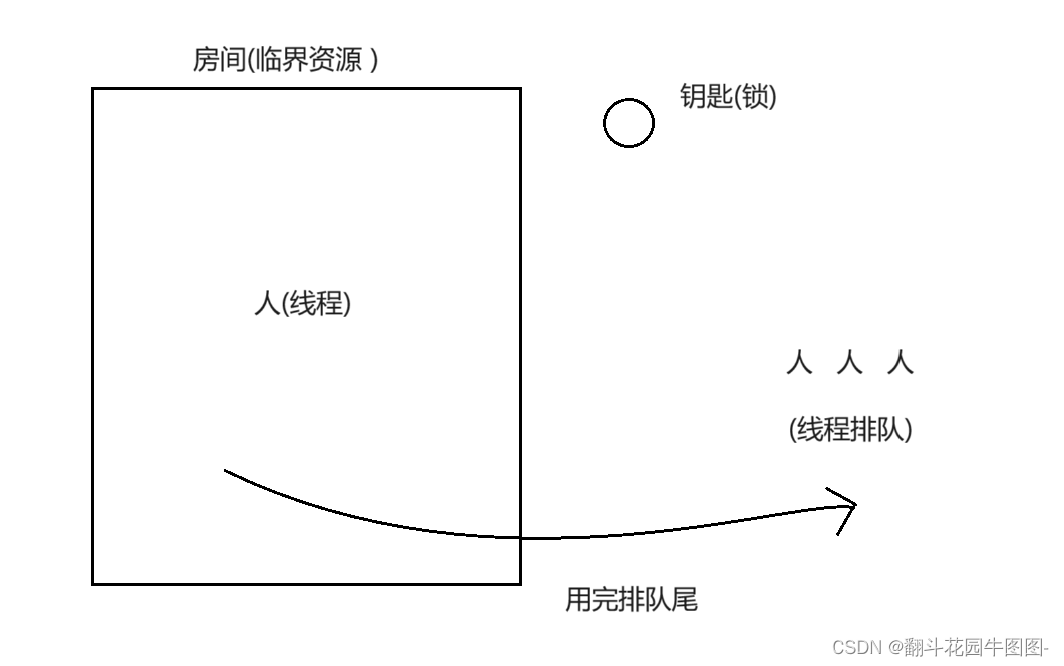
结合故事理解一下:
假设有一个房间,这个房间有且仅有对应的一把锁能够打开;这个房间在一段时间内有且只有一人能够进入里面,而想要进入里面的人很多。为了不让全部人都挤在门口,人们商量了一下,决定排队去进入这个房间,每当一个人用完此房间后就要回到这个房间的队尾,防止有人占着茅坑不拉屎
故事里的人就是线程,房间就是临界资源,钥匙就是锁
既然线程同步理解了,那么如何实现线程同步呢?需要用条件变量来实现。
1.2条件变量
条件变量的概念:用来描述某种临界资源是否就绪的一种数据化描述
结合故事理解条件变量是什么
假设有一个盘子,盘子一侧有一个哑巴,他的任务是不停地往盘子里面放水果;盘子另一侧是一队盲人,他们的任务是判断盘子里有没有水果。而这个盘子就是临界资源,盘子被锁住了,不论是谁只有抢到锁的人才能动这个盘子。
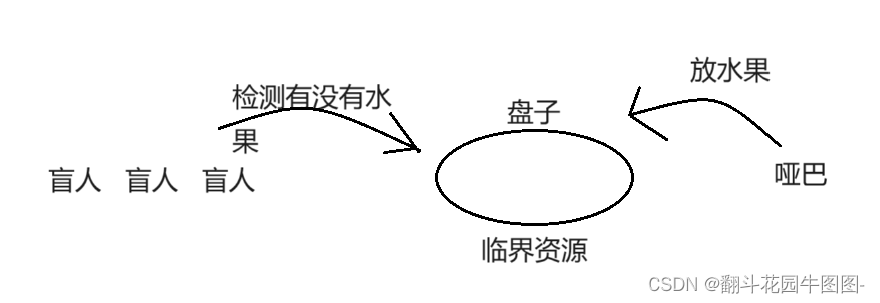
由于盲人的数量远多于哑巴,盲人又看不见,想要判断盘子里面有无水果就只能疯狂申请锁,---------->这就导致了放水果的哑巴饥饿了,抢不到锁去放水果
那么条件变量在哪呢?

别急故事还没讲完。这时候有了一个铃铛,如果盲人检测不到盘子里有水果,那么盲人就去铃铛哪里排队。当所有盲人排位队后,哑巴这时就能放水果了,放完水果后哑巴解除锁再敲一下铃铛让一个盲人(也可以叫全部盲人)去检测盘子。
条件变量 = 铃铛 + 队列
1.3条件变量的系统调用
条件变量同样是由原生线程库维护的,所以使用的是POSIX标准,和互斥锁的接口非常相似
创建条件变量:
pthread_cond_t cond;cond是英文condition的缩写
条件变量的初始化:man pthread_cond_init

参数:
pthread_cond_t *cond: 要初始化的条件变量
*cont_attr : 设为nullptr就行了
返回值:成功返回0,失败返回错误码
静态、全局的初始化
int pthread_cond_t cond = PTHREAD_COND_INITIALIZER;条件变量的销毁:man pthread_cond_destroy

参数:
*cond: 所要销毁的条件变量的地址
返回值:销毁成功返回0,失败返回错误码
条件变量的等待:man pthread_cond_wait

参数:
*cond: 所要等待的条件变量的地址
*mutex:互斥锁的地址(后面解释为什么要传锁)
返回值: 把条件变量放入等待队列,放入成功返回0,失败返回错误码
条件变量的唤醒:
man pthread_cond_signal(唤醒一个线程)

参数:
*cond: 所要等待的条件变量的地址
返回值:唤醒成功返回0,失败返回错误码
作用:由另一个线程(通常是主线程)唤醒指定条件变量等待队列中的一个线程
man pthread_cond_broadcast
![]()
参数:
*cond: 所要等待的条件变量的地址
返回值:唤醒成功返回0,失败返回错误码
作用:由另一个线程(通常是主线程)唤醒指定条件变量等待队列中的所有线程
1.4测试代码(cond系统调用的使用)
创建多个线程,用主线程控制其它线程阻塞,直到主线程唤醒才继续执行其它线程的线程函数
#include<iostream>
#include<string>
#include<vector>
#include<pthread.h>
#include<unistd.h>
using namespace std;
pthread_mutex_t gmutex = PTHREAD_MUTEX_INITIALIZER;
pthread_cond_t gcond = PTHREAD_COND_INITIALIZER;
void* MasterCode(void *args)//线程函数
{
sleep(1);
cout<<"主线程开始工作..."<<endl;
string name = static_cast<const char*>(args);
while(true)
{
int n = pthread_cond_signal(&gcond);
if(n == 0)
{
sleep(1);
cout<<"主线程唤醒一个线程..."<<endl;
}
}
}
void* SlaverCode(void *args)
{
string name = static_cast<const char*>(args);
while(true)
{
//1.加锁
pthread_mutex_lock(&gmutex);
//2.条件变量是在加锁和解锁之间使用的
pthread_cond_wait(&gcond,&gmutex);//阻塞等待主线程来唤醒
//走到这说明此线程已经被主线程唤醒了
cout<<"被唤醒的线程是:"<<name<<endl;
//解锁
pthread_mutex_unlock(&gmutex);
}
}
void StartMaster(std::vector<pthread_t> *tidsptr)
{
pthread_t tid;
int n = pthread_create(&tid,nullptr,MasterCode,(void*)"Master Thread");
if(n == 0)
{
std::cout<<"主线程创建成功"<<std::endl;
tidsptr->emplace_back(tid);
}
}
void StartSlaver(std::vector<pthread_t> *tidsptr,int thraednum)
{
for(int i=0;i<thraednum;i++)
{
char *name = new char[64];
snprintf(name,64,"Slaver-%d",i+1);
pthread_t tid;
int n = pthread_create(&tid,nullptr,SlaverCode,(void*)name);
if(n == 0)
{
std::cout<<"新线程创建成功:"<<name<<std::endl;
tidsptr->emplace_back(tid);
}
}
}
void WaitThread(std::vector<pthread_t> &tids)//等待线程
{
for(auto &tid:tids)
{
pthread_join(tid,nullptr);
}
}
int main()
{
std::vector<pthread_t> tids;//vector中放tid
StartMaster(&tids);//主线程开启(创建)
StartSlaver(&tids,4);//被控制线程(创建)
WaitThread(tids);
return 0;
}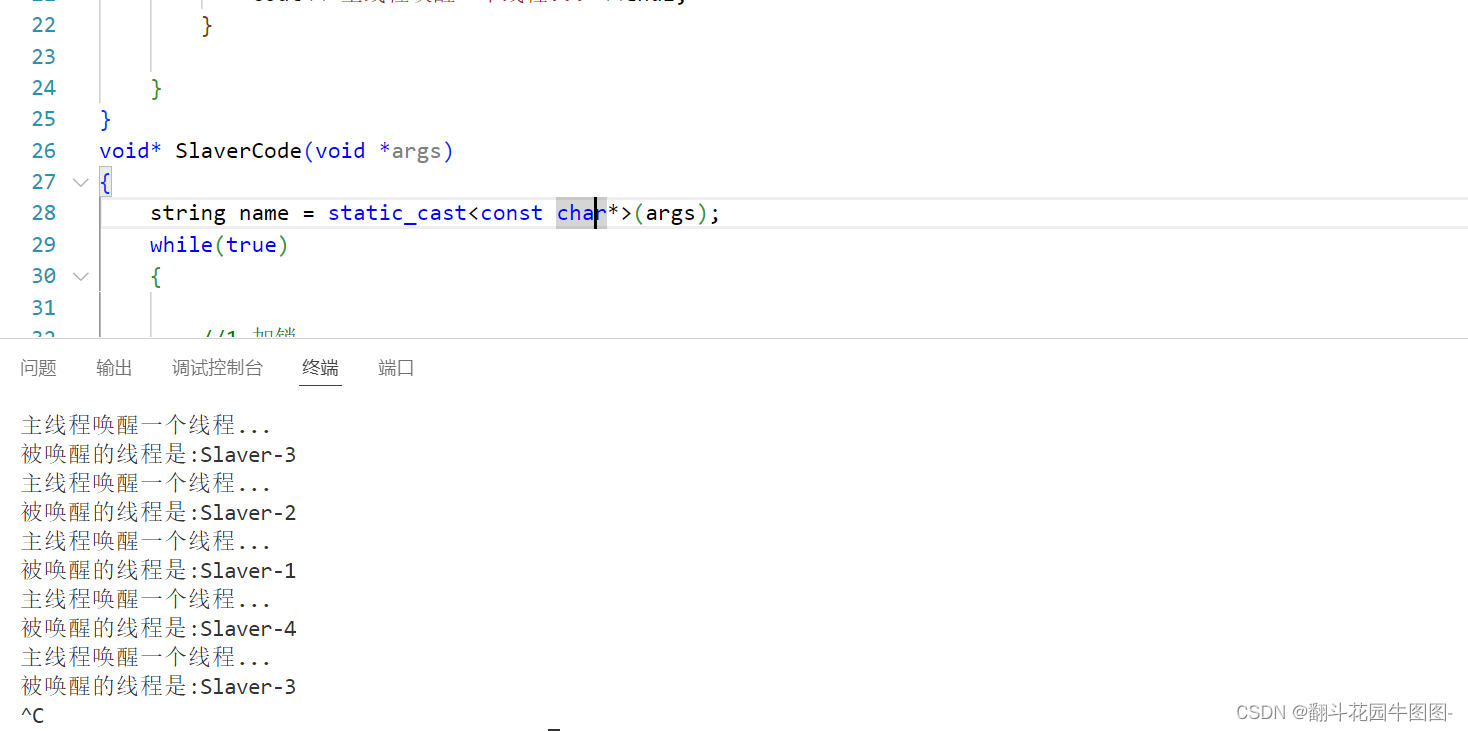
二、生产者、消费者模型
2.1生产消费模型的概念
生产、消费模型:
讨论问题的本质,如何并发的执行数据传递的问题(从一个模块传到另一个模块)
结合生活场景理解:
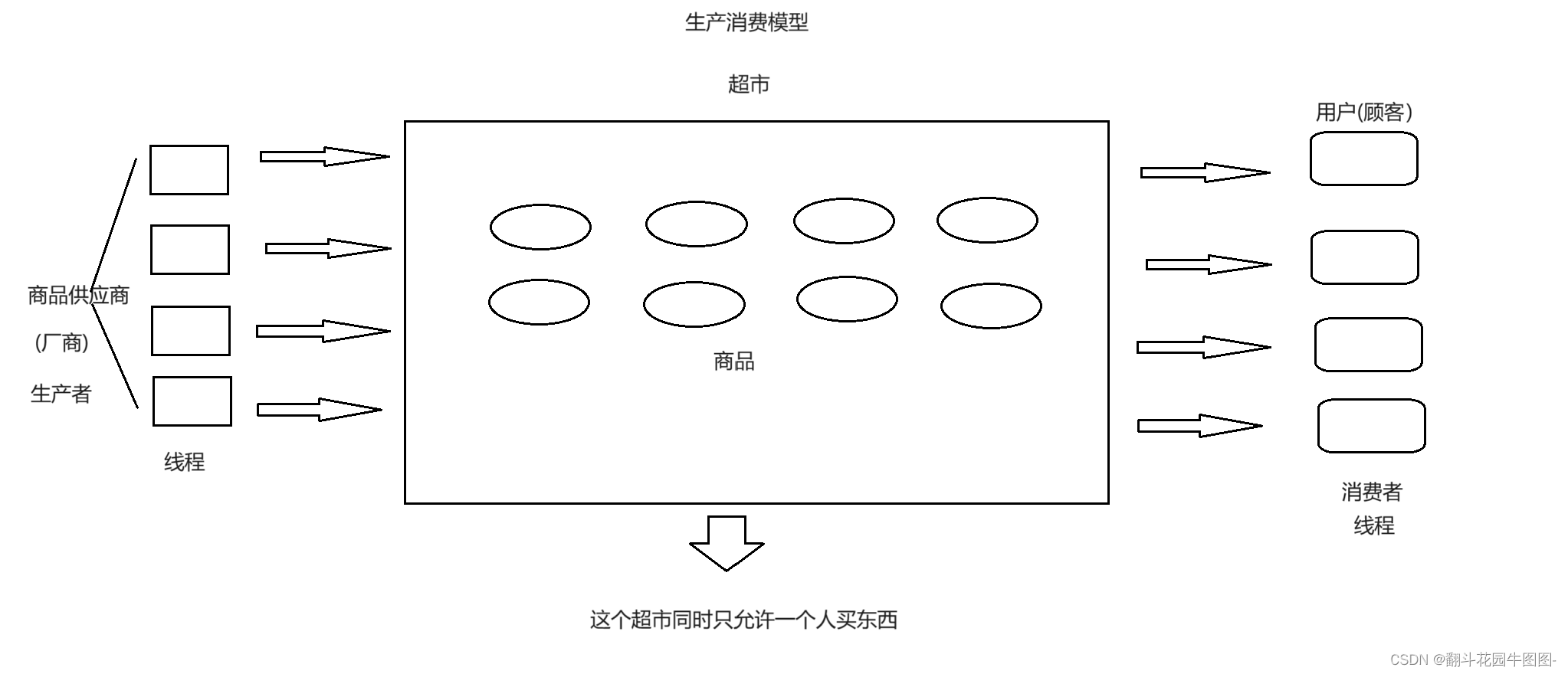
消费者线程:读取数据的线程
生产者线程:产生数据的线程
商品:数据
超市:能临时保存数据的"内存空间"(某种数据结构对象),本质是对商品的缓冲
在超市、厂商和顾客构成的生产者、消费者模型中:生产者是产品供应商,消费者是超市的顾客,而超市是一个交易产所。
超市:共享资源(要保护) ------> 临界资源
厂商、用户:多个执行流(线程)
以上结合就需要考虑线程的同步与互斥的问题
并发问题:
生产者与消费者的关系:同步&&互斥关系,厂商生产时不影响用户消费,但是厂商供货时用户不能消费。
生产者与生产者的关系:竞争关系,超市的供应商不止一家,就算是同一种商品还有不同品牌的供应商,他们彼此相互竞争,其表现就是互斥
消费者与消费者的关系:也是竞争关系,假设超市只有一种商品且这种商品只剩一份了,那么大量的消费者都要涌入这家超市,而这家超市一次只能进入一个人,所以消费者之间也是互斥
为什么说超市的本质是对商品的缓冲呢?
生产消费模型可以提供比较好的并发度(厂商生产时不影响用户消费,能做到生产和消费进行解耦,支持忙闲不均)
2.2模型实现(阻塞队列实现)
生产消费模型+条件变量
阻塞队列实现生产消费模型

2.2.1框架
Makefile
p_c_bq:Main.cc
g++ -o $@ $^ -std=c++11 -lpthread
.PHONY:clean
clean:
rm -f p_c_bq
Main.cc
#include<iostream>
#include<vector>
#include<unistd.h>
#include "Thread.hpp"
#include<functional>
#include<pthread.h>
#include "BlockQueue.hpp"
using namespace Thread_Module;
void* productor(BlockQueue<int> &bq)
{
int a = 1;
while(true)//获取任务
{
//...
}
return nullptr;
}
void* consumer(BlockQueue<int> &bq)
{
while(true)//制作任务
{
//...
}
return nullptr
}
void Comm(std::vector<Thread<BlockQueue<int>>> *threads,int num,BlockQueue<int> &bq,func_t<BlockQueue<int>> func)
{
for(int i=0;i<num;i++)
{
std::string name = "thread-"+std::to_string(i+1);
threads->emplace_back(func,bq,name);
threads->back().Start();
}
}
void ProductorStart(std::vector<Thread<BlockQueue<int>>> *threads,int num,BlockQueue<int> &bq)
{
Comm(threads,num,bq,productor);
}
void ConsumerStart(std::vector<Thread<BlockQueue<int>>> *threads,int num,BlockQueue<int> &bq)
{
Comm(threads,num,bq,consumer);
}
void WaitAllThread(std::vector<Thread<BlockQueue<int>>> &threads)
{
for(auto &thread:threads)
{
thread.Join();
}
}
int main()
{
BlockQueue<int> *bq = new BlockQueue<int>(5);
std::vector<Thread<BlockQueue<int>>> threads;
ProductorStart(&threads,1,*bq);
ConsumerStart(&threads,1,*bq);
WaitAllThread(threads);
return 0;
}BlockQueue.hpp
#include<iostream>
#include<string>
#include<queue>
#include<pthread.h>
template <class T>
class BlockQueue
{
public:
BlockQueue(int cap)//构造
:_cap(cap)
{
pthread_mutex_init(&_mutex,nullptr);//锁的初始化
//条件变量的初始化
pthread_cond_init(&_product_cond,nullptr);
pthread_cond_init(&_consumer_cond,nullptr);
}
//生产者用的接口(入阻塞队列)
void Enqueue(T &in)
{
pthread_mutex_lock(&_mutex);
//...
pthread_mutex_unlock(&_mutex);
}
//消费者用的接口(出队列)
void Pop(T *out)
{
pthread_mutex_lock(&_mutex);
//...
pthread_mutex_unlock(&_mutex);
}
//析构
~BlockQueue()
{
pthread_mutex_destroy(&_mutex);
pthread_cond_destroy(&_product_cond);
pthread_cond_destroy(&_consumer_cond);
}
private:
std::queue<T> _bq;//阻塞队列
int _cap;//队列上限
pthread_mutex_t _mutex;//锁
pthread_cond_t _product_cond;//生产者的条件变量
pthread_cond_t _consumer_cond;//消费者的条件变量
};之前的封装的线程注意 T _data数据需要引用 T &_data
#include<iostream>
#include<signal.h>
#include<unistd.h>
#include<functional>
#include<pthread.h>
namespace Thread_Module
{
template <typename T>
using func_t = std::function<void(T&)>;
// typedef std::function<void(const T&)> func_t;
template <typename T>
class Thread
{
public:
void Excute()
{
_func(_data);
}
public:
Thread(func_t<T> func,T &data,const std::string &threadname = "none")
:_threadname(threadname)
,_func(func)
,_data(data)
{}
static void* threadrun(void *args)//线程函数
{
Thread<T> *self = static_cast <Thread<T>*>(args);
self->Excute();
return nullptr;
}
bool Start()//线程启动!
{
int n = pthread_create(&_tid,nullptr,threadrun,this);
if(!n)//返回0说明创建成功
{
_stop = false;//说明线程正常运行
return true;
}
else
{
return false;
}
}
void Stop()
{
_stop = true;
}
void Detach()//线程分离
{
if(!_stop)
{
pthread_detach(_tid);
}
}
void Join()//线程等待
{
if(!_stop)
{
pthread_join(_tid,nullptr);
}
}
std::string threadname()//返回线程名字
{
return _threadname;
}
~Thread()
{}
private:
pthread_t _tid;//线程tid
std::string _threadname;//线程名
T &_data;//数据
func_t<T> _func;//线程函数
bool _stop; //判断线程是否停止 为true(1)停止,为false(0)正常运行
};
}2.2.2代码完善
生产者调用接口和消费者调用接口进行实现
void Enqueue(const T &in) // 生产者用的接口
{
pthread_mutex_lock(&_mutex);
while(IsFull())//判断队列是否已经满了
{
pthread_cond_wait(&_product_cond, &_mutex); //满的时候就在此情况下等待
// 1. pthread_cond_wait调用是: a. 让调用进程等待 b. 自动释放曾经持有的_mutex锁
}
// 进行生产
_bq.push(in);
// 通知消费者来消费
pthread_cond_signal(&_consumer_cond);
pthread_mutex_unlock(&_mutex);
}
void Pop(T *out) // 消费者用的接口
{
pthread_mutex_lock(&_mutex);
while(IsEmpty())
{
pthread_cond_wait(&_consumer_cond, &_mutex);
}
// 进行消费
*out = _bq.front();
_bq.pop();
// 通知生产者来生产
pthread_cond_signal(&_product_cond);
pthread_mutex_unlock(&_mutex);
}1. pthread_cond_wait调用是: a. 让调用进程等待 b. 自动释放曾经持有的_mutex锁
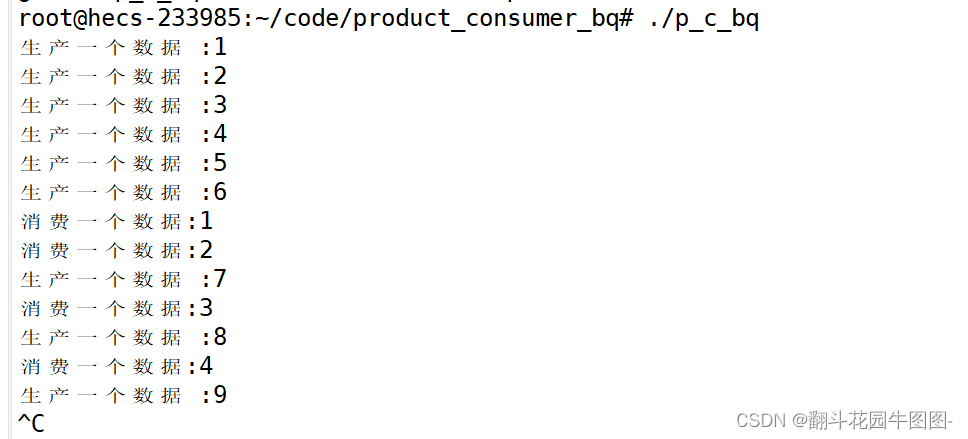
再对生产者消费者接口进行完善
在Block_Queue类里面再添加两个成员变量,对生产者、消费者的阻塞(等待)数量进行计数,在唤醒生产者、消费者线程这一语句再加一个判断语句:判断阻塞计数>0才可唤醒
#include<iostream>
#include<string>
#include<queue>
#include<pthread.h>
template <class T>
class BlockQueue
{
private:
//判断队列是否为满(满就入不了队列)
bool IsFull()
{
return _bq.size() == _cap;
}
//判断队列是否为空(为空出不了队列)
bool IsEmpty()
{
return _bq.size() == 0;
}
public:
BlockQueue(int cap)//构造
:_cap(cap)
{
pthread_mutex_init(&_mutex,nullptr);//锁的初始化
//条件变量的初始化
pthread_cond_init(&_product_cond,nullptr);
pthread_cond_init(&_consumer_cond,nullptr);
_product_wait_n = 0;
_consumer_wait_n = 0;
}
//生产者用的接口(入阻塞队列)
void Enqueue(T &in)
{
pthread_mutex_lock(&_mutex);
while(IsFull())
{
_product_wait_n++;
pthread_cond_wait(&_product_cond,&_mutex);//生产者等待消费者唤醒
_product_wait_n--;
}
//走到这已经被唤醒了
//生产者开始生产
_bq.push(in);
// std::cout<<in<<std::endl;
//pthread_cond_signal(&_consumer_cond);
if(_consumer_wait_n > 0)//如果有等待的消费者唤醒消费者来消费
{
pthread_cond_signal(&_consumer_cond);
}
pthread_mutex_unlock(&_mutex);
}
//消费者用的接口(出队列)
void Pop(T *out)
{
pthread_mutex_lock(&_mutex);
while(IsEmpty())
{
_consumer_wait_n++;
pthread_cond_wait(&_consumer_cond,&_mutex);
_consumer_wait_n--;
}
//走到这已经被唤醒了
//开始消费
*out = _bq.front();
// std::cout<<out<<std::endl;
_bq.pop();
//唤醒生产者来生产
pthread_cond_signal(&_product_cond);
if(_product_wait_n>0)
{
pthread_cond_signal(&_product_cond);
}
pthread_mutex_unlock(&_mutex);
}
// void Enqueue(const T &in) // 生产者用的接口
// {
// pthread_mutex_lock(&_mutex);
// while(IsFull())//判断队列是否已经满了
// {
// pthread_cond_wait(&_product_cond, &_mutex); //满的时候就在此情况下等待
// }
// // 进行生产
// _bq.push(in);
// // 通知消费者来消费
// pthread_cond_signal(&_consumer_cond);
// pthread_mutex_unlock(&_mutex);
// }
// void Pop(T *out) // 消费者用的接口
// {
// pthread_mutex_lock(&_mutex);
// while(IsEmpty())
// {
// pthread_cond_wait(&_consumer_cond, &_mutex);
// }
// // 进行消费
// *out = _bq.front();
// _bq.pop();
// // 通知生产者来生产
// pthread_cond_signal(&_product_cond);
// pthread_mutex_unlock(&_mutex);
// }
//析构
~BlockQueue()
{
pthread_mutex_destroy(&_mutex);
pthread_cond_destroy(&_product_cond);
pthread_cond_destroy(&_consumer_cond);
}
private:
std::queue<T> _bq;
int _cap;//队列上限
pthread_mutex_t _mutex;
pthread_cond_t _product_cond;//生产者的
pthread_cond_t _consumer_cond;//消费者的
int _product_wait_n;//生产者的阻塞数
int _consumer_wait_n;//消费者的阻塞数
};




















 454
454











 被折叠的 条评论
为什么被折叠?
被折叠的 条评论
为什么被折叠?








